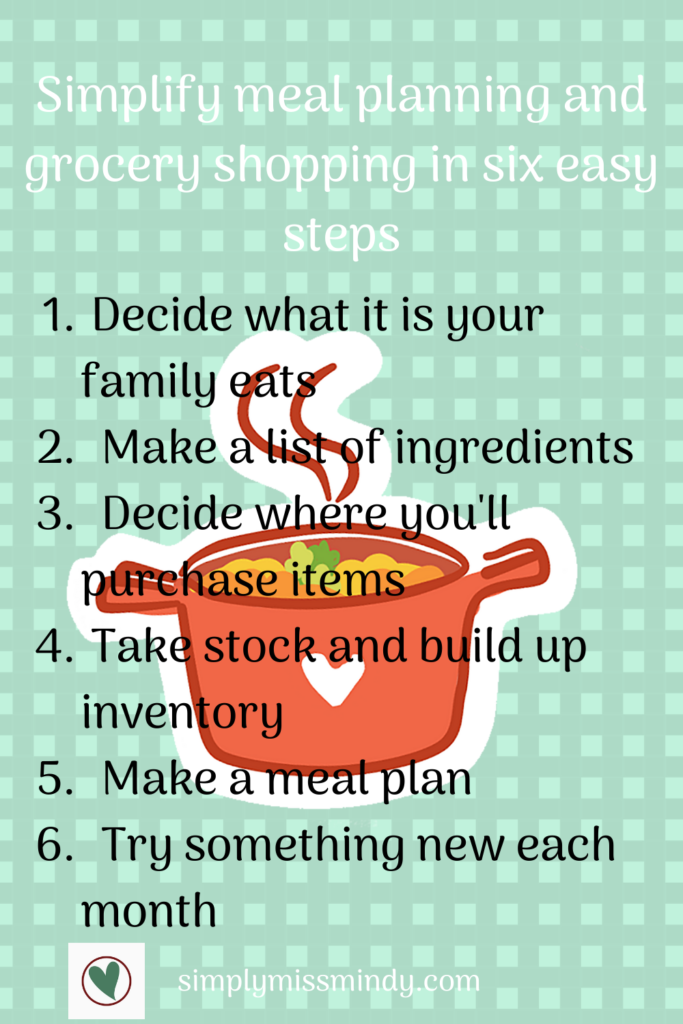
Hold on to your hats, people. This is a big one.
If your family is anything like mine, food takes up a big portion of your budget…..and shopping, cooking, and thinking about food takes up a huge amount of your bandwidth.
I have a large family, so I have always been focused on how to create large meals that will fill everyone up without breaking the bank. But even if there are only a few people in your household, food is hard to simplify. I hope to give you some tips and hope today.
I want to start by telling you that my system has been heavily influenced by Amy Dacyczyn. If you haven’t heard of her, you need to look her up, because she was the simple living guru of my generation. She started a little newsletter called The Tightwad Gazette, all about–you guessed it–how to save money and live frugally. That spiraled into books and speaking engagements and magazine articles. Some of her ideas were, and remain, a little out there; but no one can deny that she knew what she wanted and did what she needed to do to get there. Rumor has it she’s living the dream in rural Maine.
Anyway, I read (and read, and re-read) her books and gleaned a lot of wisdom from them, and the one concept that I learned from her that I still use today is what she called “The Pantry Principle.” I adapted it to my own style and it’s the method I’m going to teach you now.
Here is how I simplify meal planning and grocery shopping:
STEP 1: Decide what it is your family eats.
This seems basic, but I find it’s the hardest part. It’s difficult to give up the dream of being a great cook. I love recipes and trying new things in the kitchen, but there are really only a few things that I make that everyone eats and enjoys. We really are creatures of habit, and there’s no reason to fix something that isn’t broken, especially if the things your family likes are healthy and balanced. (Side note: not everything has to be! If you occasionally make tater tots and fish sticks, put that on the list!). Make your list of things your family actually, really, truly eats. This isn’t the time to pretend you are someone you’re not. You will probably find that your meal list is shorter than you expected. I suspect most families probably cycle through only 10-12 meals on a regular basis.
Make lists for breakfast, lunch, and dinner. Some lists may be shorter than others; I find that dinner takes up the most space. Your kids might eat lunch at school, or you may grab a sandwich every day from the place next to work, or whatever. This isn’t a list of what you WISH your family ate, but WHAT THEY ACTUALLY EAT. No guilt. No judgement, of yourself or others.
Here is my list:
BREAKFAST:
oatmeal
cereal and milk
eggs, scrambled and fried
toast
pancakes (weekends)
bacon (weekends)
smoothies
LUNCH:
kids eat at school
salad with chicken
soup
sandwiches
DINNER:
fried rice with chicken
spaghetti and meatballs
chicken and potato curry on rice
tacos/taco bowls
lasagna
turkey/mashed potatoes
barbequed burgers/chips
stir fry over rice
pancakes and bacon (yep, breakfast night once in a while)
pizza
SNACKS/OTHER:
coffee
creamer
cheese sticks
fruit snacks
kombucha
seltzer water
crystal light (in water bottles)
apples
bananas
oranges
m&ms
protein shakes
cereal bars
microwave popcorn
peanut butter
Now, this isn’t an exhaustive list; I have given you an abbreviated one from my own life to use as an example. You will want to write down every single thing your family regularly eats. If you only come up with six dinners that you like, who cares? As long as your family is happy, why try to change it?
So now we move on to the next step:
STEP 2: make a list of all the ingredients that go into each and every meal.
I’m not going to do my whole list, because that would take up too much of this post, but let’s look at my list for the dinners above. Don’t leave any parts out!
rice (W)
frozen chicken chunks (W)
soy sauce (C)
Chinese five spice powder (W)
frozen peas (W)
frozen corn (W)
frozen carrot pieces (W)
vegetable oil (W)
spaghetti noodles (W)
frozen meatballs (C)
pasta sauce (W)
curry sauce (W)
potatoes (W) *
coconut milk (W)
frozen ground beef (C)
taco seasoning (C)
salsa (W)
grated cheese (C)
sour cream (W) *
pinto beans (can) (W)
avocado (W) *
tortillas (W)
frozen lasagna (C)
turkey (W) (seasonal)
jar gravy (W)
frozen hamburger patties (C)
hamburger buns (W) *
pickles (W)
tomatoes (W) *
ketchup (W)
mustard (W)
mayonnaise (W)
lettuce (W) *
frozen stir fry vegetables (C)
pancake mix (C)
bacon (C)
eggs (W) *
syrup (W)
You’ll notice that I didn’t put anything on the list more than once, even though it may be used in more than one meal. For instance, I use frozen chicken chunks in both my fried rice and my curry dish, but I only put it on the list when I put the ingredients for the fried rice, and skipped it when I got to curry, because it was already on the list. You may want to put a tally mark next to an ingredient each time it’s repeated so you know how much you need. As a bonus, I actually put my list into a Word document and then sort it alphabetically and in columns, so I have one page of the items my pantry needs to have stocked to be able to make any of the meals on my meal list.
STEP 3: Go through your list and decide which store you will purchase each item from.
In my case, I really only have two stores I frequent: Winco (W) and Costco (C). I’ve already marked my list with which things I purchase where.
Now, I want to pause and give you a little warning about Costco. I love Costco, and I find that the savings benefit is worth the membership each year, BUT it can be a very dangerous place. Some things are a really good buy, and some things are just higher quality than any other place, so I’m willing to pay a little more. But it’s easy to get caught up in the low-looking prices and the sheer number of wonderful things on offer. If your goal is to save money, either go in with a friend who can keep you accountable to only buy the things on your list, or find another place to shop. Really!
You’ll notice some of my items also have an asterisk next to them. These are things that don’t keep very long and so must be purchased in the week they’re going to be used. More on that in a minute.
STEP 4: Go through your pantry and see which things you already have in stock; plan to build up your inventory of the rest.
Your goal, you see, is to always have the ingredients on hand to make the majority of the meals on your list at a moment’s notice. These are things you know your family will eat, and things you could make in your sleep. Let’s be honest, we all have days where we have planned to make something specific, and when dinnertime comes, we’re just not feeling it. That’s the time to pull out one of the old standbys and whip something up quick.
This is where the Pantry Principle comes into play. Instead of planning for meals for the week and then going out and buying the ingredients needed, we are going to do exactly the opposite: stock the pantry regularly with the items you need to feed your family, and THEN plan what meals you will make that week.
In my case, I go to Costco monthly and stock up on the things I regularly purchase there. (A freezer is a very helpful tool for this!) Then I make a weekly trip to Winco, where I stock up on the pantry items.
STEP 5: look at your week and make a meal plan.
Before the weekly shopping trip, I sit down with my planner. Oh friends, I can’t wait to talk about planners…..but that’s for another day. Anyway, I look at the week ahead and jot down from my list of tried and true meals what I think we will probably have for dinner that week, taking special note of our schedule and how much time I’ll have for cooking each day. (Side note: I don’t generally plan for breakfast or lunch. My kids make their own and/or get it at school, and I grab whatever I’m hungry for. But if you are regularly cooking those meals for your family, put them in your plan.) Then I note any ingredients that have to be purchased fresh because they won’t keep (asterisk items above), and make sure to put those on my list for the week.
This is where I veer from Amy’s method a bit. I do think it’s important to have at least a loose plan of what we will eat, at least for dinner, each week. I look at what our family is up to and decide if I want to do something in the crock pot, or in the air fryer, or if there’s a day I can assign one of my kids to do some of the preparation, or whatever. I don’t find it simple to wait until nearly dinnertime and then decide what to make, even if I know I have the ingredients in my pantry and freezer that I need to make most of the meals we regularly eat. If I wait until evening, the simple thing is to order take-out, and that is a budget-buster! It also keeps us from eating healthy most of the time. We are trying to simplify and make it easier to plan and prepare meals that work for our families, and planning ahead makes that possible.
STEP 6: Add one new meal each month if you have the time and energy.
I love recipes and I often see something that looks like it may fit my family, but I don’t want to add the inventory for that meal to my pantry until I’m sure it’s something we may put into regular rotation. So my solution is to try it once. I add the ingredients to my list for the week and cook it up on a day that I have extra time for thinking and cooking. Sometimes it’s a hit, in which case I add it again the next month to see if it really stands up to family scrutiny. If it does, I add it to my list and its ingredients to my pantry list and put it into regular rotation. Sometimes it’s a bust, so I throw out the leftovers and move on! (Just kidding. My husband will almost always eat leftovers, no matter what the meal was. I try not to waste food.) Don’t feel bad if you didn’t hit on a winner this month. You only bought enough to prepare it once, so you haven’t wasted food or money; and one of these days you’ll find something that just works.
So, that’s it, folks. My six-step solution to simplifying meal planning and grocery shopping. What do you think? Let me know in the comments, and if you give it a try, I’d love to hear how it goes for you.
Oh, and if you can get ahold of Amy’s books, I highly recommend that you look at her suggestions for a price book, which takes this whole thing one step further and helps to save you money at the grocery store.
Blessings, Mindy
